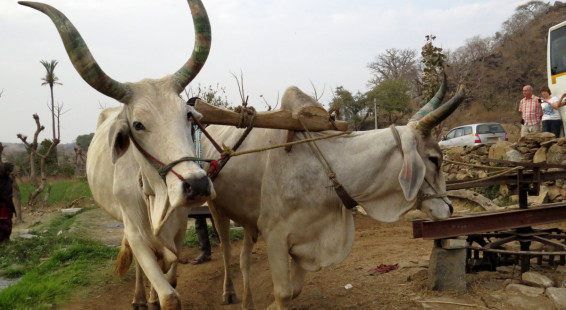
While traveling across rural Rajasthan, en route from Jaipur to Udaipur, our guide stopped the bus beside a farm. The point of the stop was for us to see how a water wheel is still used in agriculture. There was a large metallic mechanism beside the road apparently connected to a water wheel; after a chat with the farmer, a pair of oxen were attached to the steel bar and we were shown how the water wheel worked.
This type of water wheel is called a sakia, or Persian wheel (although it likely was invented in India around 300 BC). The device is designed to lift water from a well using buckets or scoops connected to an endless belt activated by turning such a wheel. This is in contrast to a noria, a water wheel which uses the water power obtained from the flow of a river to draw water.
In a sakia, a vertical wheel is attached by a drive shaft to a horizontal wheel and allows access to water in deep wells. The wheels are set in motion by animal power (in our case a pair of oxen). Besides India, sakias are used in Egypt, the Iberian Peninsula, and Middle Eastern countries. As was the case with the sakia we saw, most are used for crop irrigation.
The concept is simple and a surprisingly large quantity of water was drawn from a very deep well in short order. An interesting look at how an ancient technology is still applied to farming in India and in some ways a metaphor for the country — steeped in tradition but in its own way striving for the 21st century.